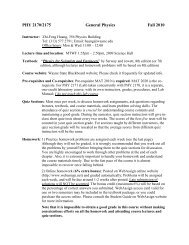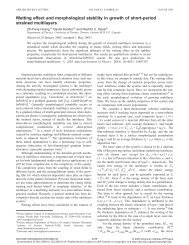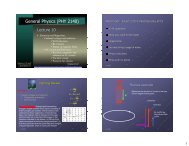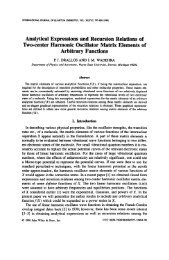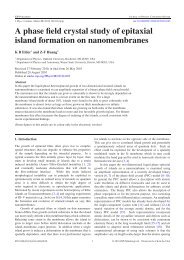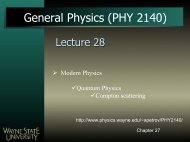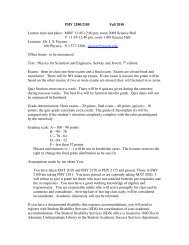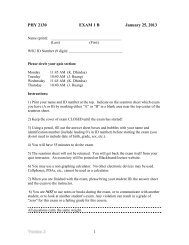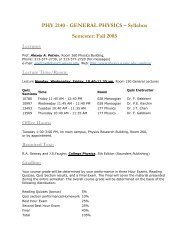pdf file
pdf file
pdf file
- No tags were found...
You also want an ePaper? Increase the reach of your titles
YUMPU automatically turns print PDFs into web optimized ePapers that Google loves.
General Physics (PHY 2130)Lecture 20• Rotational dynamics equilibrium 2 nd Newton’s Law for rotational motion rolling• Exam II reviewhttp://www.physics.wayne.edu/~apetrov/PHY2130/
Lightning ReviewLast lecture:1. Momentum:momentum conservationcollisions in one and two dimensionsReview Problem: An engineer wishes to design a curved exit ramp for a toll road insuch a way that a car will not have to rely on friction to round the curve withoutskidding. She does so by banking the road in such a way that the force causing thecentripetal acceleration will be supplied by the component of the normal forcetoward the center of the circular path. A highway curve has a radius of 825 m. Atwhat angle should the road be banked so that a car traveling at 26.8 m/s has notendency to skid sideways on the road? (Hint: No tendency to skid means thefrictional force is zero.)
Review ProblemAn engineer wishes to design a curved exit ramp for a toll road in such a way that a car will nothave to rely on friction to round the curve without skidding. She does so by banking the road insuch a way that the force causing the centripetal acceleration will be supplied by the componentof the normal force toward the center of the circular path. A highway curve has a radius of 825m. At what angle should the road be banked so that a car traveling at 26.8 m/s has no tendencyto skid sideways on the road? (Hint: No tendency to skid means the frictional force is zero.)yθNTake the car’s motion to be into the page. Draw FBD andapply Newton’s Second Law:2v( 1)∑ Fx= N sinθ= mar= mr2 F = N cosθ− w =( ) 0∑ywθxDivide (3) by (4):Rewrite (1) and (2): ( 3) N sinθ = m v2r( 4) N cosθ = mg2( 26.8 m/s)( 9.8 m/s )( 825 m)2vtanθ= =2grθ = 5.1°=0.089
Last time: what if two or moredifferent forces act on lever arm?
Net Torque• The net torque is the sum of all the torques produced byall the forces• Remember to account for the direction of the tendency for rotation• Counterclockwise torques are positive• Clockwise torques are negative
Example 1:Determine the net torque:N4 m 2 mGiven:weights: w 1 = 500 Nw 2 = 800 Nlever arms: d 1 =4 md 2 =2 m500 N1. Draw all applicable forces800 NFind:Στ = ?2. Consider CCW rotation to be positive∑τ = (500 N)(4 m) + ( −)(800 N)(2 m)=+ 2000 N⋅m−1600N⋅m=+ 400 N⋅mRotation would be CCW
Where would the 500 N person have tobe relative to fulcrum for zero torque?
Axis of Rotation• So far we have chosen obvious axis of rotation• If the object is in equilibrium, it does not matterwhere you put the axis of rotation for calculatingthe net torque• The location of the axis of rotation is completely arbitrary• Often the nature of the problem will suggest aconvenient location for the axis• When solving a problem, you must specify an axis ofrotation• Once you have chosen an axis, you must maintain that choiceconsistently throughout the problem
Calculating the Center of Gravity1. The object is divided up into a large numberof very small particles of weight (mg)2. Each particle will have a set of coordinatesindicating its location (x,y)3. The torque produced by each particle aboutthe axis of rotation is equal to its weight timesits lever arm4. We wish to locate the point of application ofthe single force , whose magnitude is equalto the weight of the object, and whose effecton the rotation is the same as all theindividual particles.• This point is called the center of gravity of theobject
Coordinates of the Center of Gravity• The coordinates of the center of gravity can be foundfrom the sum of the torques acting on the individualparticles being set equal to the torque produced bythe weight of the objectxcg=Σm xiΣmiiandycg=Σm yiΣmii• The center of gravity of a homogenous, symmetricbody must lie on the axis of symmetry.• Often, the center of gravity of such an object is thegeometric center of the object.
Example:Find center of gravity of the following system:Given:masses: m 1 = 5.00 kgm 2 = 2.00 kgm 3 = 4.00 kglever arms: d 1 =0.500 md 2 =1.00 mFind:Center of gravityxcg=∑∑m ximiim1x1+ m2x2+ m3x=m + m + m125.00 kg(−0.500m)+ 2.00 kg(0m)+ 4.00 kg(1.00m)=11.0kg= 0.136m33
Experimentally Determining the Center ofGravity• The wrench is hung freely from twodifferent pivots• The intersection of the linesindicates the center of gravity• A rigid object can be balanced by asingle force equal in magnitude toits weight as long as the force isacting upward through the object’scenter of gravity
Equilibrium, once again• A zero net torque does not mean the absence of rotationalmotion• An object that rotates at uniform angular velocity can be under theinfluence of a zero net torque• This is analogous to the translational situation where a zero net forcedoes not mean the object is not in motion
More on Free Body Diagrams• Isolate the object to beanalyzed• Draw the free bodydiagram for that object• Include all the externalforces acting on the object
ExampleSuppose that you placed a 10 m ladder(which weights 100 N) against the wallat the angle of 30°. What are the forcesacting on it and when would it be inequilibrium?
Example:Given:weights: w 1 = 100 Nlength: l=10 mangle: α=30°Στ = 0Find:f = ?n=?P=?α 1. Draw all applicable forces2. Choose axis of rotation at bottom corner (τ of f and n are 0!)Torques: Forces:L ∑τ= mg cos30 − PLsin302110 = 100 N ⋅ ⋅0.866− P ⋅1⋅22P = 86.6 N= 0∑∑FFmgxy= f − P = 0f= 86.6 N= n − mg = 0n = 100 Nf 86.6 NNote: f = µ s n, so µ s= = = 0. 866n 100 N
So far: net torque was zero.What if it is not?
Torque and Angular Acceleration• When a rigid object issubject to a net torque(≠0), it undergoes anangular acceleration• The angular acceleration isdirectly proportional to thenet torque• The relationship is analogousto ∑F = ma• Newton’s Second Law
Torque and Angular AccelerationFF r,( ma )tangentialattt==ma= rα,sotmultiply bytF tr =rracceleration :2mr αtorque τ dependent upon object and axisof rotation. Called moment ofinertia I. Units: kg m 2I ≡ Σm r2i iτ =IαThe angular acceleration is inversely proportionalto the analogy of the mass in a rotating system
Newton’s Second Law for a RotatingObject• The angular acceleration is directly proportional to the net torque• The angular acceleration is inversely proportional to the moment ofinertia of the objectΣτ= Iα• There is a major difference between moment of inertia and mass: themoment of inertia depends on the quantity of matter and itsdistribution in the rigid object.• The moment of inertia also depends upon the location of the axis ofrotation
Example:Consider a flywheel (cylinder pulley) of mass M=5 kg andradius R=0.2 m and weight of 9.8 N hanging from ropewrapped around flywheel.What are forces acting on flywheel and weight? Findacceleration of the weight.mg
Example:NI =12MR2= 0.10 kg ⋅m2TGiven:MgTmasses: M = 5 kgweight: w = 9.8 Nradius: R=0.2 mmg1. Draw all applicable forcesFind:Forces=?atT == αRororIR2atForces: Torques:∑F = mg −T= maneed T!Tangential acceleration at the edge of flywheel (a=a t ):atTR=I20.10 kg ⋅m=( 0.2 m)22at=( 2.5kg) a t∑a =F = mg −T= mamg −mgτ = T ⋅ R = I ⋅α( 2.5kg)( m + 2.5kg)at9.8 N=3.5kgT ⋅ Rα =I= ma= 2.8ms2
Note on problem solving:• The same basic techniques that were used in linearmotion can be applied to rotational motion.• Analogies: F becomes τ, m becomes I and a becomes αbecomes ω and x becomes θ• Techniques for conservation of energy are the same asfor linear systems, as long as you include the rotationalkinetic energy• Problems involving angular momentum are essentiallythe same technique as those with linear momentum• The moment of inertia may change, leading to a change inangular momentum, v
Review before Exam 2Useful tips:1. Do and understand all the homework problems.2. Review and understand all the problems done in class.3. Review and understand all the problems done in the textbook(chapters 4-7).4. Come to office hours if you have questions!!!
Exam Review



